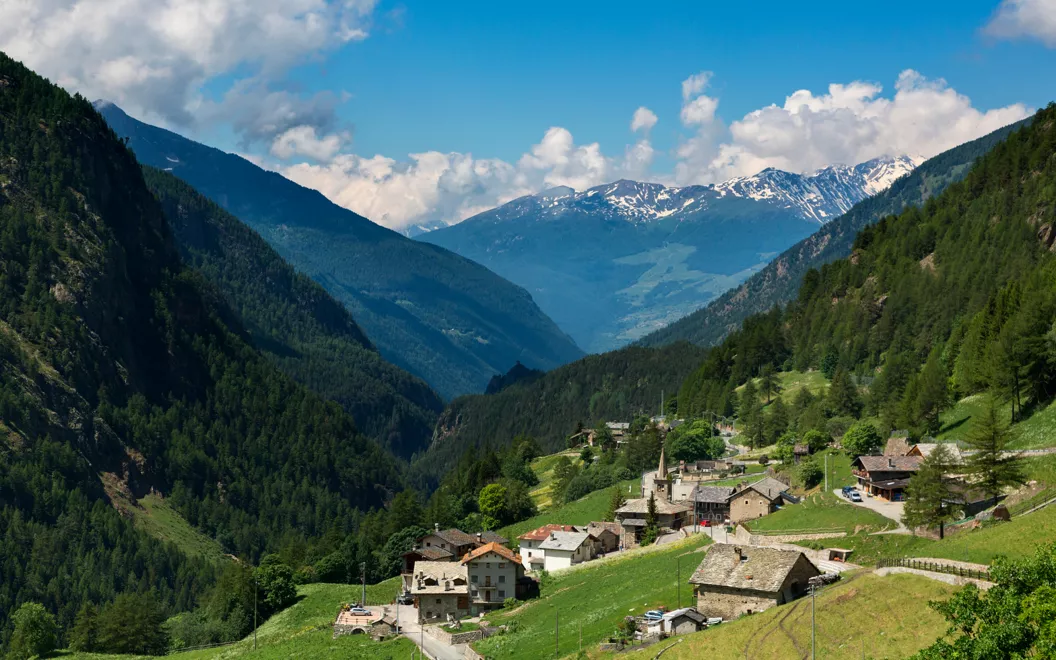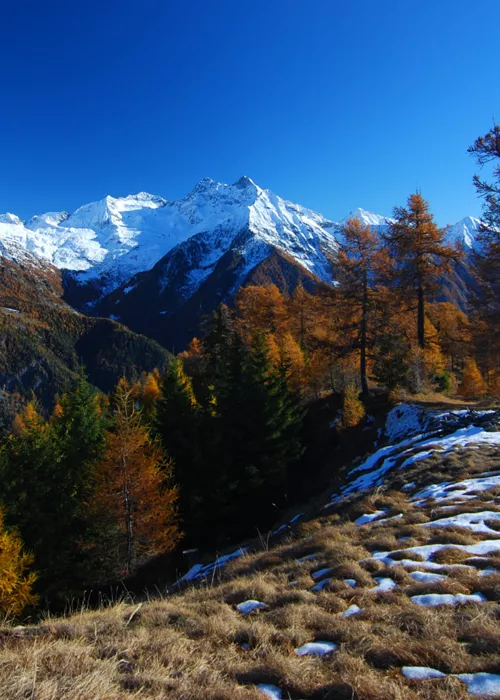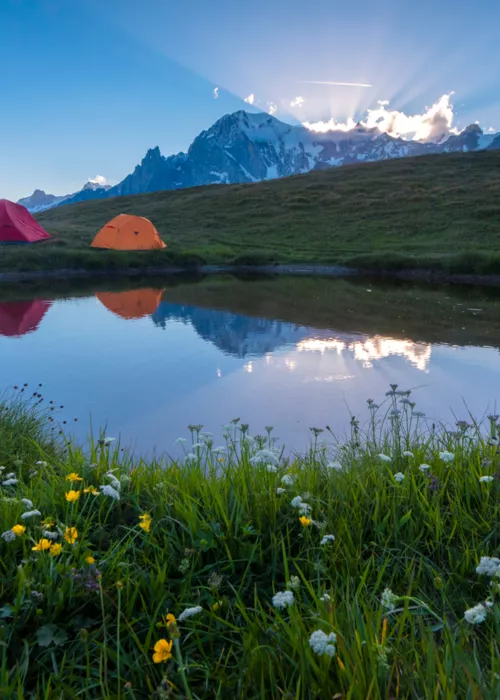Aosta

Strategically located in the centre of the region, in a lush sunny basin at the confluence of the Buthier stream in the Dora Baltea river, Aosta is the only real city in the Aosta Valley. Before exploring the pedestrian streets of the historic centre, you can park your bike in one of the car parks scattered around the city streets, knowing that it will soon be time to get back in the saddle again for the next stage.
Founded by the Romans (who gave it the name "Augusta Praetoria") around 25 BC, Aosta has since been a frontier city, crossed by the trade routes that connect the Mediterranean Sea and Northern Europe. Artists and merchants, armies and royal courts have passed through the city's gates, leaving traces of their passage in the monuments and traditions that today enhance a visit to Aosta.
The history of this city, a crossroads of people and cultures, gives those who discover it pearls of art and culture, to be savoured with the eyes and the mind before turning to the tarmac covering the winding roads of the Aosta Valley.
One very special statistic says that, after Rome, Aosta is the city in the world with the highest concentration of archaeological sites from the Roman era. You have to follow the ancient city walls, gates, towers and triumphal arches or the long orthogonal streets of the historic centre to imagine what Aosta might have looked like in the first centuries after its foundation. Perhaps the monument that best represents ancient times in the mountains of the Aosta Valley is the romano theatre of the 1st century BC: a grandiose structure, capable of immediately astonishing those who, from the northern provinces of the empire, descended towards Rome through the present-day Aosta Valley.
Evidence of mediaeval and Christian sacred art in the city can be found among the rich naves of the Aosta Cathedral, dedicated to S. Maria Assunta, or along the cloisters and frescoed chapels of the collegiate church of St Orso. A centuries-old tree, or perhaps a thousand-year-old tree, survives in the square in front of the collegiate church of St Orso: a gnarled lime tree that, if it could speak, would tell anecdotes and historical events of the astonishing capital of the Aosta Valley.
Valle d'Aosta castles from Sarre to Saint-Pierre

Symbolically starting with the elegant piazza Chanoux, exact geographical centre of the city of Aosta, the bike route pushes westwards, in the direction of three historical manors located along the banks of the Dora Baltea river.
Along the way, there are a number of vineyards that provide quality wines thanks to the excellent climate enjoyed by this large, breezy and sunny section of the central valley in the Aosta Valley. Some varieties are native, such as Petit-rouge, Prié and Fumin, others are from France, Switzerland and Piedmont, but have also found a welcoming environment in the Aosta Valley: just think of three excellent whites such as Chardonnay, Muscat Blanc and Petite Arvine. The gradient of the Valdostan vineyards ensures even sunlight, and the many dry-stone walls along the terraces store heat during the day and release it at night.
Nestled between vineyards and orchards, and bordered by forests of fir and chestnut trees at the foot of the mountains, Sarre is the first historically significant village you come across when travelling west from Aosta. Once past the slim profile of the bell tower of the village parish church, you ascend to the right, in the direction of the royal castle of Sarre. Its appearance is of a residential rather than defensive castle: in fact, it was remodelled during the 18th century by the Savoy dynasty, at a time when protection from enemy attacks was no longer essential.
Continue by motorbike towards the village of Saint-Pierre, just a few minutes away. Two ancient fortresses stand out in the municipal area: the Saint-Pierre Castle named after the village of the same name and the Sarriod de la Tour Castle by the family that had built it. The first manor house faces the valley from the top of a rocky headland and proudly displays its fairy-tale appearance, with elegant turrets added to the original structure during a 19th-century restoration. The castle of Saint-Pierre houses the rooms of the Regional Museum of Natural Sciences Efisio Noussan, along a recently renovated visit route with the addition of interactive installations.
The Sarriod de la Tour castle, on the other hand, has a markedly different appearance, lying in a flat area just a few metres from the Dora Baltea river crossing. The oldest architectural section of the castle dates back as far as the 10th-12th century, but over the following centuries interventions ordered by members of the noble Sarriod family led to various modifications, until in the 1970s the castle became the property of the Autonomous Region of Valle d'Aosta.
Introd

Four beautiful valleys stretch southwards from the immediate surroundings of Saint-Pierre, moving towards the right bank of the Dora Baltea river. Before leaving to explore the winding roads that cross two of these four valleys, the Valgrisenche and the Valsavarenche, deserves a thorough stop, however the ancient village of Introd, a few minutes' drive from Saint-Pierre, is also worth a thorough stop.
Orange Flag of the Italian Touring Club thanks to its sustainable tourist accommodation system, Introd is set between two streams: the Dora di Rhêmes (which gives its name to the valley of the same name) and the Savara stream, which touches the banks of the Valsavaranche. It seems that the place name Introd derives from the French "entre-eaux", meaning "between the waters".
For those who feel like stretching their legs and getting off the bike, Introd offers a developed network of trails and hikes that climb up to streams and rock faces. The historic centre of the village is known for its mediaeval castle and for its centuries-old houses and complexes of rural origin, such as the Ôla farmhouse or the Maison Bruil. In these ancient spaces scattered among the village's alleys, the local community organises exhibitions and events to promote the area.
Finally, the village is particularly known for its wildlife park. The Parc Animalier d'Introd is home to a number of animal species typical of the Aosta Valley Alps. Chamois, marmots, ibex, deer and hares inhabit an enchanted landscape, coloured and perfumed by native plants and flowers.
Valgrisenche

Moving slightly to the west, the itinerary skirts the town of Arvier, the starting point of a panoramic regional road that climbs towards Valgrisenche. The ruins of Montmayeur Castle welcome the motorcyclist at the entrance to the valley. Slightly higher up, a Christian shrine, known as Rochefort, provides a splendid view of the surrounding area.
From Montmayeur Castle, a few kilometres wind through rocky gorges and hairpin bends to the Lake Beauregard, which marks the end of the Valgrisenche. It is an artificial lake enclosed by a deep dam.
Valgrisenche is a destination appreciated in all seasons by hikers and mountaineers. The large Rutor glacier overlooks the traditional houses scattered over the ridges of this narrow valley from above. In summer, lush green meadows and pine and fir forests welcome travellers for a relaxing picnic, in particular in the Usellières locality. In the surrounding area, it is not difficult to spot groups of whistling marmots or large herds of cows passing through the high-altitude pastures in the summer months.
Before getting back on the bike to retrace the Valgrisenche road in reverse, returning to Arvier and then to Introd, the traveller can devote some time to the discovery of one of the most prized craft products in the entire Aosta Valley. The draps of Valgrisenche are local fabrics made from local sheep's wool using an ancient system of maple wood looms. The decorations of these fabrics show fascinating geometric patterns: often the draps of Valgrisenche, instead of being worn, are hung on the walls or placed on the floor to embellish the houses of the Aosta Valley.
Valsavarenche

Another small but picturesque valley rises south from Introd, through a grid of streets that winds along steep hairpin bends. It is the Valsavaranche, crossed by the Savara stream: it is one of the privileged access points for mountaineers and climbers to access the Gran Paradiso National Park.
All around Pont, a village at the southern end of the Valsavaranche, there is an intricate system of trails and hikes that ascend to unspoilt peaks and plateaus. A crown of alpine peaks dominates the landscape of the Valsavaranche: the Grivola, the Ciarforon, theHerbetet and the Tresenta, to mention four of the most famous peaks, all exceeding 3,500 metres in altitude.
The fauna and flora of Gran Paradiso inhabit a fascinating natural landscape, composed of glacial lakes, waterfalls and high-altitude alpine meadows. In the Gran Paradiso National Park, the luckiest will be able to get to know some of the animals typical of this part of Italy, such as the ibex goat (better known as alpine ibex) or the majestic bearded vulture, a large predatory vulture typical of these areas.
Those who wish to stay a night in the Valsavaranche mountain huts will be unable to resist looking up at the starry sky. The Aosta Valley is one of the most popular regions for those who like to gaze at the celestial vault in summer thanks to the total absence of light pollution in its valleys. It is no coincidence that this region has one of the most visited astronomical observatories in Italy, that of Saint Barthélemy, located just above Fénis.
Valpelline

Returning from Valsavaranche towards Aosta, the traveller will have to ride north this time, once again crossing the course of the Dora Baltea river and steering the front wheel of the bike towards Valpelline.
From the main village at the beginning of the valley, continue eastwards for about 20 kilometres along the banks of the Buthier stream. A series of winding curves awaits the motorcyclist, particularly between the towns of Grenier, Oyace and Bionaz. You climb up to the large car park that runs along the dam of Place Moulin, a hydroelectric barrier that marks the geographical end of the Valpelline.
Leaving your bike in the car park, you can walk along a footpath that runs along the banks of a long, narrow artificial lake. A centuries-old larch tree marks the end of the footpath and the start of the mountaineering trail: from here, looking up to the north, you can see the profile of the Dent d 'Herens, a snow-capped peak that marks the border between Italy and Switzerland.
Valpelline is among the localities in Valle d'Aosta that best represent the regional food and wine traditions. One of the local specialities, for example, served on tables all over the Aosta Valley, is seupa à la valpellinentze: a tasty cabbage soup with stale white bread, to which bacon, butter and cheese are added in large quantities. But Valpelline and the adjacent Ollomont valley are also famous for their game meats, sausages or fish caught in the alpine streams.
Those who have been truly bewitched by the intense flavour of Val d'Aosta Fontina PDO should not miss a visit to the Museum and visitor centre in Valpelline at Frissonière. Local residents claim that the Valpelline fontina is the best in the Aosta Valley: after a visit to the museum, it will be hard to argue with them.
Fénis

Descending one last time towards the wide and sunny central valley of Aosta, the motorbike route takes a diversion in the direction of the soaring turrets of Fénis Castle, one of the region's most recognisable and visited historical monuments.
The mediaeval fortress lies a few steps from the right bank of the Dora Baltea river, along the main Aosta Valley trade routes but not exactly in a strategic position from a defensive point of view. In fact, the fields surrounding Fénis Castle are mostly flat and barren, making it easy to walk and ride. It becomes clear after a few steps that this fortress had never had a real military role in the defence of the valley. It was, in fact, built as a stately residence by the aristocratic Challant family, lords of the Aosta Valley in the mediaeval and later Renaissance periods.
The Challants abandoned Fénis Castle in the early 18th century. The mighty manor remained uninhabited until, at the end of the 19th century, restoration and renovation work began that allowed it to be opened to the public and restored it to its former glory.
In addition to the castle of the same name, since 2009 Fénis has also been home to the MAV - Museum of Traditional Valdostan Craftsmanship. Lovers of local tradition will then be able to conclude this motorcycling itinerary among the natural and cultural beauties of the Aosta Valley here.







